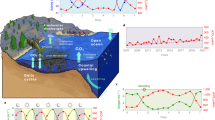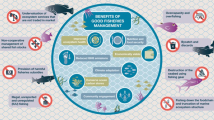Abstract
arising from B. S. Halpern et al. Nature 488, 615–620 (2012)10.1038/nature11397
How close to maximum sustainable food provision is current seafood harvest from the world’s oceans? Halpern et al.1 suggest that the answer is 25% from a global index of food provision, part of their multifaceted index of ocean health. Rigorous methods used for management, however, demonstrate that their food provision index is uncorrelated with actual food provision, and that global ocean food provision is in the range of 71–95%. Their results stem from an uncertain method of estimating maximum sustainable yield (MSY), and we believe that this approach should be avoided as a measure of food provision. There is a Reply to this Brief Communication Arising by Halpern, B. S. et al. Nature 495, http://dx.doi.org/10.1038/nature11975 (2013).
This is a preview of subscription content, access via your institution
Access options
Subscribe to this journal
Receive 51 print issues and online access
$199.00 per year
only $3.90 per issue
Buy this article
- Purchase on Springer Link
- Instant access to full article PDF
Prices may be subject to local taxes which are calculated during checkout


Similar content being viewed by others
References
Halpern, B. S. et al. An index to assess the health and benefits of the global ocean. Nature 488, 615–620 (2012)
Pauly, D. Focusing One’s Microscope: Daniel Pauly on the State of Global Fisheries http://blog.nature.org/2011/01/daniel-pauly-fish-stock-global-world-fisheries/ (2011)
Worm, B. et al. Rebuilding global fisheries. Science 325, 578–585 (2009)
Froese, R. & Proelß, A. Rebuilding fish stocks no later than 2015: will Europe meet the deadline? Fish Fish. 11, 194–202 (2010)
Sumaila, U. R. et al. Benefits of rebuilding global marine fisheries outweigh costs. PLoS ONE 7, e40542 (2012)
Arnason, R., Kelleher, K. & Willmann, R. The Sunken Billions. The Economic Justification for Fisheries Reform. (World Bank and FAO, 2008)
Costello, C. et al. Status and solutions for the world’s unassessed fisheries. Science 338, 517–520 (2012)
Ryther, J. Photosynthesis and fish production in the sea. Science 166, 72–76 (1969)
Pauly, D. One hundred million tonnes of fish, and fisheries research. Fish. Res. 25, 25–38 (1996)
FAO. The State of World Fisheries and Aquaculture 2012 (Food and Agriculture Organization of the United Nations, 2012)
Ricard, D., Minto, C., Baum, J. K. & Jensen, O. P. Examining the knowledge base and status of commercially exploited marine species with the RAM Legacy Stock Assessment Database. Fish Fish. 13, 380–398 (2012)
Branch, T. A., Jensen, O. P., Ricard, D., Ye, Y. & Hilborn, R. Contrasting global trends in marine fishery status obtained from catches and from stock assessments. Conserv. Biol. 25, 777–786 (2011)
Daan, N., Gislason, H., Pope, J. G. & Rice, J. C. Apocalypse in world fisheries? The reports of their death are greatly exaggerated. ICES J. Mar. Sci. 68, 1375–1378 (2011)
Carruthers, T. R., Walters, C. J. & McAllister, M. K. Evaluating methods that classify fisheries stock status using only fisheries catch data. Fish. Res. 119–120, 66–79 (2012)
Hilborn, R. & Branch, T. A. Does catch reflect abundance? No, it is misleading. Nature 494, 303–306 (2013)
Thorson, J. T., Cope, J. M., Branch, T. A. & Jensen, O. P. Spawning biomass reference points for exploited marine fishes, incorporating taxonomic and body size information. Can. J. Fish. Aquat. Sci. 69, 1556–1568 (2012)
Author information
Authors and Affiliations
Contributions
T.A.B. designed the study, T.A.B. and D.J.H. analysed the data, and T.A.B. and R.H. discussed the results and wrote the paper together.
Corresponding author
Ethics declarations
Competing interests
Declared none.
PowerPoint slides
Rights and permissions
About this article
Cite this article
Branch, T., Hively, D. & Hilborn, R. Is the ocean food provision index biased?. Nature 495, E5–E6 (2013). https://doi.org/10.1038/nature11974
Received:
Accepted:
Published:
Issue Date:
DOI: https://doi.org/10.1038/nature11974
This article is cited by
-
A fish cartel for Africa
Nature Communications (2023)
-
Removing biases in forecasts of fishery status
Journal of Bioeconomics (2014)
-
Halpern et al. reply
Nature (2013)
-
Exploring Patterns of Seafood Provision Revealed in the Global Ocean Health Index
AMBIO (2013)
Comments
By submitting a comment you agree to abide by our Terms and Community Guidelines. If you find something abusive or that does not comply with our terms or guidelines please flag it as inappropriate.



